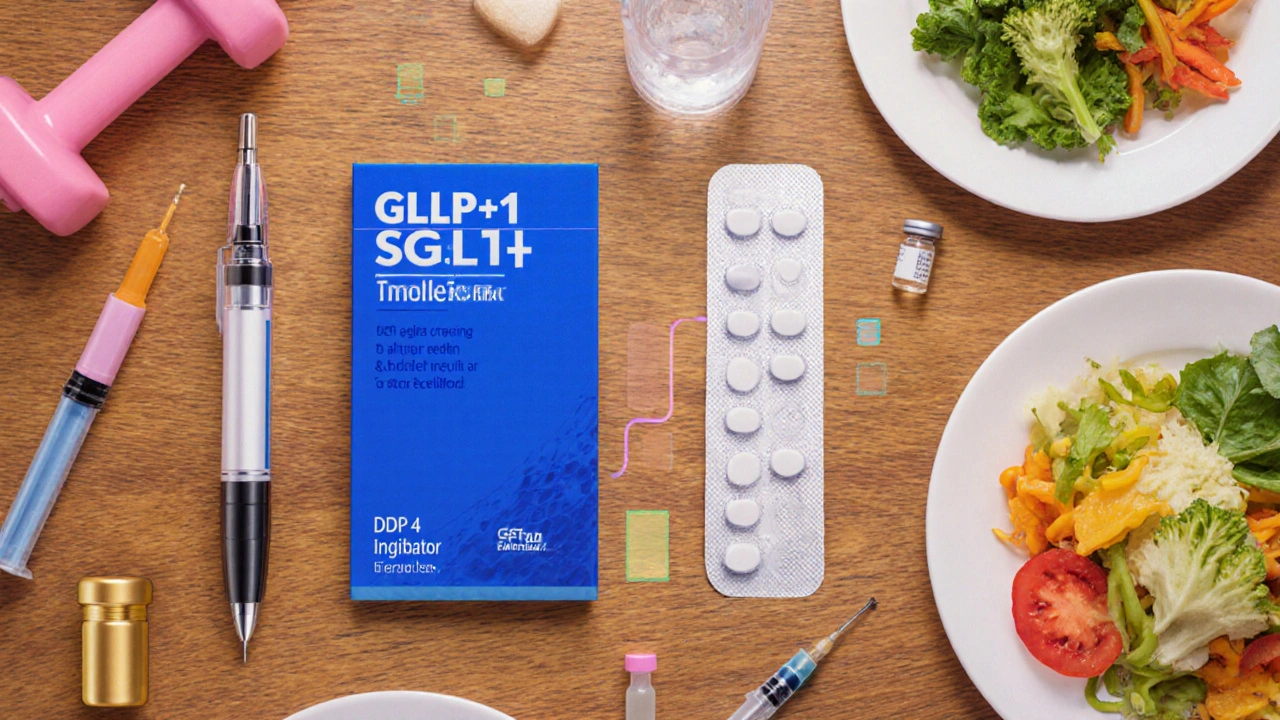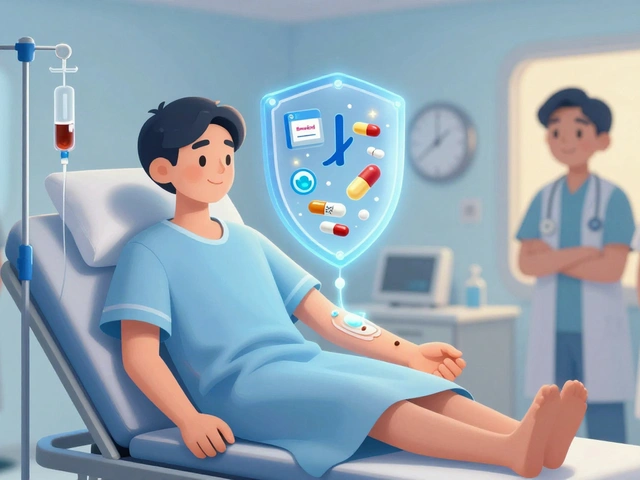Metformin vs Alternatives: Decision Guide
Your Priorities
Important Considerations
Recommended Approach
Select your priorities and considerations, then click "Analyze My Situation" to get personalized recommendations based on current evidence.
Drug Comparison Table
| Drug/Class | Mechanism | Typical Dose Range | Cost (AU$ per month) | Weight Effect | Major Side Effects |
|---|---|---|---|---|---|
| Metformin | Reduces hepatic gluconeogenesis; improves peripheral insulin sensitivity | 500 mg – 2,000 mg daily | ≈20–30 | Neutral to mild loss | GI upset, rare lactic acidosis |
| GLP‑1 agonist (e.g., semaglutide) | GLP‑1 receptor activation → ↑ insulin, ↓ glucagon, slower gastric emptying | 0.5 mg weekly (injectable) | ≈350–400 | Significant loss (2–5 kg) | Nausea, vomiting, pancreatitis risk |
| SGLT2 inhibitor (e.g., empagliflozin) | Blocks renal glucose reabsorption | 10 mg – 25 mg daily | ≈150–180 | Modest loss (1–3 kg) | UTIs, genital mycotic infections, dehydration |
| DPP‑4 inhibitor (e.g., sitagliptin) | Inhibits DPP‑4 enzyme → ↑ endogenous GLP‑1 | 100 mg daily | ≈120–150 | Neutral | Headache, nasopharyngitis, rare pancreatitis |
| Pioglitazone | PPAR‑γ activation → ↑ insulin sensitivity | 15 mg – 45 mg daily | ≈80–100 | Often weight gain | Edema, heart‑failure risk, bone fracture |
Drug Information Cards
Best for: First-line therapy, cost-effective, mild weight loss, established safety profile
Limitations: May cause GI upset, contraindicated in severe kidney disease
Best for: Significant weight loss, strong glucose control, appetite suppression
Limitations: Injectable, higher cost, potential GI side effects
Best for: Cardiovascular and renal protection, modest weight loss
Limitations: Requires normal kidney function, risk of UTIs and genital infections
Best for: Minimal side effects, convenient oral administration
Limitations: Limited glucose lowering effect
Best for: Insulin sensitization, especially in PCOS
Limitations: Weight gain, fluid retention, heart failure risk
When doctors need to bring down blood sugar in people with type 2 diabetes, Metformin is the go‑to oral drug because it’s cheap, well‑studied, and usually well‑tolerated.
- Understand how Metformin works and when it shines
- See the most common alternatives side‑by‑side
- Learn practical tips for picking the right option for you or your patient
- Avoid common pitfalls that can waste time or cause side effects
- Get answers to the questions people ask most about these drugs
What is Metformin?
Metformin is a biguanide that mainly reduces liver glucose output and improves peripheral insulin sensitivity.
It was first approved in the 1950s and has since become the most prescribed first‑line therapy for type 2 diabetes. Typical dosing starts at 500mg once daily and can be titrated up to 2,000mg+daily, split into two or three doses.
Key advantages: low cost, neutral or modest weight loss, long safety record, and a slight cardiovascular benefit in large trials. The most common side effect is mild GI upset, which usually eases with a gradual dose increase.
Why Look at Alternatives?
Even though Metformin works for most, a growing number of patients need something else. Reasons include:
- Intolerance to gastrointestinal side effects despite dose adjustments
- Insufficient HbA1c reduction after 3-6months of maximized Metformin
- Obesity or a desire for weight loss beyond Metformin’s modest effect
- Specific cardiovascular or kidney concerns that newer drug classes address
- Pregnancy, liver disease, or other comorbidities that limit Metformin use
When any of these flags pop up, clinicians typically add or switch to a newer class: GLP‑1 agonists, SGLT2 inhibitors, DPP‑4 inhibitors, or thiazolidinediones like pioglitazone. Lifestyle changes and insulin also stay on the table.

Overview of the Main Alternatives
GLP‑1 agonist (e.g., semaglutide) mimics the gut hormone GLP‑1, boosting insulin secretion, slowing gastric emptying, and curbing appetite.
SGLT2 inhibitor (e.g., empagliflozin) blocks glucose reabsorption in the kidney, causing excess glucose to be flushed in urine.
DPP‑4 inhibitor (e.g., sitagliptin) prevents degradation of endogenous GLP‑1, modestly enhancing insulin release.
Pioglitazone belongs to the thiazolidinedione class; it activates PPAR‑γ receptors to improve insulin sensitivity in muscle and fat.
Lifestyle modification-diet, exercise, weight loss-remains a cornerstone and can be combined with any drug.
Insulin is still the most potent glucose‑lowering therapy, reserved for later stages or when oral agents fail.
Side‑by‑Side Comparison
| Drug/Class | Mechanism | Typical Dose Range | Cost (AU$ per month) | Weight Effect | Major Side Effects |
|---|---|---|---|---|---|
| Metformin | Reduces hepatic gluconeogenesis; improves peripheral insulin sensitivity | 500mg-2,000mg daily | ≈20-30 | Neutral to mild loss | GI upset, rare lactic acidosis |
| GLP‑1 agonist (e.g., semaglutide) | GLP‑1 receptor activation → ↑ insulin, ↓ glucagon, slower gastric emptying | 0.5mg weekly (injectable) | ≈350-400 | Significant loss (2-5kg) | Nausea, vomiting, pancreatitis risk |
| SGLT2 inhibitor (e.g., empagliflozin) | Blocks renal glucose reabsorption | 10mg-25mg daily | ≈150-180 | Modest loss (1-3kg) | UTIs, genital mycotic infections, dehydration |
| DPP‑4 inhibitor (e.g., sitagliptin) | Inhibits DPP‑4 enzyme → ↑ endogenous GLP‑1 | 100mg daily | ≈120-150 | Neutral | Headache, nasopharyngitis, rare pancreatitis |
| Pioglitazone | PPAR‑γ activation → ↑ insulin sensitivity | 15mg-45mg daily | ≈80-100 | Often weight gain | Edema, heart‑failure risk, bone fracture |
All numbers are averages for the Australian market in 2025 and can vary by brand and insurance coverage.
How to Choose the Right Option
Picking a drug isn’t just about the chemistry; it’s about the person. Use this three‑step mental checklist:
- Assess clinical priorities: Do you need stronger HbA1c lowering, weight loss, or cardiovascular protection?
- Check contraindications: Kidney function, heart failure, history of pancreatitis, or pregnancy status can rule out certain classes.
- Factor in practicalities: Cost, dosing frequency, injection aversion, and insurance coverage.
For example, a 55‑year‑old with obesity, a recent heart‑failure admission, and an eGFR of 55mL/min/1.73m² would likely benefit from an SGLT2 inhibitor (cardio‑renal benefit) plus Metformin if tolerated. Conversely, a young professional who dislikes needles might stay on oral agents and add a DPP‑4 inhibitor for modest further reduction.
Practical Tips & Common Pitfalls
- Start low, go slow with Metformin. A 500mg dose taken with dinner often cuts nausea in half.
- Don’t ignore renal thresholds. SGLT2 inhibitors require eGFR≥45mL/min; below that, stick with Metformin or choose a DPP‑4 inhibitor.
- Watch for hidden weight gain. Pioglitazone can add 2-4kg, which may offset its glucose benefits for overweight patients.
- Combine with lifestyle. Even a 5% body‑weight loss can improve insulin sensitivity as much as adding a second oral agent.
- Plan for hypoglycemia. Only insulin and sulfonylureas carry a high risk; most newer agents are glucose‑dependent and safe.
Frequently Asked Questions
Can I take Metformin and a GLP‑1 agonist together?
Yes. The combination is common because Metformin tackles hepatic glucose production while GLP‑1 agonists add strong post‑prandial control and weight loss. Monitoring for GI upset is advised.
Why might my doctor stop Metformin after years of use?
Reasons include worsening kidney function (eGFR <30mL/min), persistent GI intolerance, or insufficient HbA1c reduction despite max dose. In those cases, a switch to an SGLT2 inhibitor or addition of a GLP‑1 agonist is typical.
Is there a benefit of SGLT2 inhibitors beyond glucose lowering?
Absolutely. Large trials (e.g., EMPA‑REG OUTCOME) showed lower rates of cardiovascular death, heart‑failure hospitalization, and slowed kidney disease progression, especially in patients with existing cardiac or renal issues.
Do DPP‑4 inhibitors cause weight gain?
They are weight‑neutral for most people, making them a safe add‑on when weight loss isn’t a primary goal.
What should I do if I experience frequent urinary infections on an SGLT2 inhibitor?
Stay well‑hydrated, practice good genital hygiene, and talk to your doctor. Sometimes dose reduction or switching to another class is necessary.
Bottom line: Metformin remains the backbone of type2 diabetes treatment, but the expanding toolbox lets clinicians tailor therapy to each patient’s health profile, weight goals, and financial situation. By weighing mechanism, cost, and side‑effect profile, you can decide whether to stay with Metformin alone or move to a newer alternative.





October 6, 2025 AT 17:55 PM
When we look at the landscape of type‑2 diabetes pharmacotherapy, Metformin still occupies the cornerstone position because of its cost‑effectiveness and decades of safety data.
However, the decision matrix becomes richer once we layer in patient‑specific priorities such as weight management, cardiovascular risk, and renal function.
Starting with the basics, Metformin’s mechanism of reducing hepatic gluconeogenesis while enhancing peripheral insulin sensitivity translates into modest HbA1c reductions that are usually sufficient for early disease.
The drug’s neutral to mild weight‑loss effect also makes it attractive for patients who are mildly overweight but not yet eligible for more aggressive interventions.
In contrast, GLP‑1 agonists such as semaglutide deliver a double‑pronged benefit of stronger glucose lowering and clinically meaningful weight loss, often in the range of 2‑5 kg.
The trade‑off lies in injection administration and a substantially higher price tag, which can be a barrier for many health‑care systems.
SGLT2 inhibitors occupy a unique niche by offering cardiovascular and renal protection on top of modest glycemic improvement and weight loss.
They do, however, require a baseline eGFR of roughly 45 mL/min/1.73 m² and carry a risk of genitourinary infections that patients need to be counseled about.
DPP‑4 inhibitors sit comfortably in the “well‑tolerated” category, providing modest HbA1c reductions with a once‑daily oral regimen and a low incidence of adverse effects.
Their downside is that they rarely achieve the weight‑loss or cardiovascular benefits seen with the GLP‑1 or SGLT2 classes.
Pioglitazone, a thiazolidinedione, can be a useful add‑on for insulin sensitization, especially in patients with features of metabolic syndrome, but clinicians must monitor for fluid retention and potential heart‑failure exacerbation.
When counseling patients, it is helpful to map each drug’s profile onto the individual’s comorbidities, cost constraints, and lifestyle preferences.
For instance, a young professional who dislikes injections and values simplicity may stay on Metformin and add a DPP‑4 inhibitor, whereas a patient with established atherosclerotic disease might benefit more from an SGLT2 inhibitor regardless of cost.
Early and slow titration of Metformin-starting at 500 mg with meals-can mitigate gastrointestinal side effects and improve adherence.
Moreover, pairing Metformin with a modestly low‑glycemic diet amplifies its efficacy without adding pharmacologic burden.
Ultimately, a shared decision‑making approach that respects the patient’s values while integrating the latest evidence will lead to the most sustainable outcomes.
October 9, 2025 AT 01:29 AM
Sure, because we all love a cheap pill that occasionally makes you feel like you swallowed a coffee grinder. It's not like the newer drugs bring any real innovation, right? Just keep grinding that Metformin and hope for the best.
October 11, 2025 AT 09:02 AM
Life is a series of choices and drugs are but mirrors of those choices we often ignore the deeper meaning of metabolic balance yet Metformin remains a simple solution that many accept without questioning its place in modern therapy while newer agents promise miracles the market loves but the patient may not need them
October 13, 2025 AT 16:35 PM
Honestly the idea of swapping Metformin for a flashy injectable feels like a status symbol rather than a medical necessity.
October 16, 2025 AT 00:09 AM
Stop glorifying Metformin like it's a miracle and ignore the elephant in the room-its GI side effects can ruin daily life for many patients. If you can't handle that, look elsewhere.
October 18, 2025 AT 07:42 AM
Hey there! I love how you laid out the pros and cons, and I think adding a quick tip about taking Metformin with dinner can really help with those stomach issues. Keep the practical advice coming!
October 20, 2025 AT 15:15 PM
From a clinical economics perspective the cost disparity between Metformin and GLP‑1 agonists is staggering; 🤔 the pharmaceutical industry appears to prioritize profit over patient accessibility. Moreover, the marketing hype surrounding weight loss often eclipses the modest glycemic benefits. One must remain vigilant against such manipulative narratives. 📊
October 22, 2025 AT 22:49 PM
🚀 Let’s turbo‑charge your diabetes management! By synergizing Metformin’s hepatic action with the incretin boost of GLP‑1 agonists, you can achieve optimal glycemic control while leveraging adipose‑tissue remodeling. Embrace the combo, stay compliant, and watch those numbers drop! 🌟
October 25, 2025 AT 06:22 AM
Metformin still beats most pills on price.
October 27, 2025 AT 13:55 PM
Actually the hype around cost ignores the hidden expenses of monitoring side effects and compliance issues.